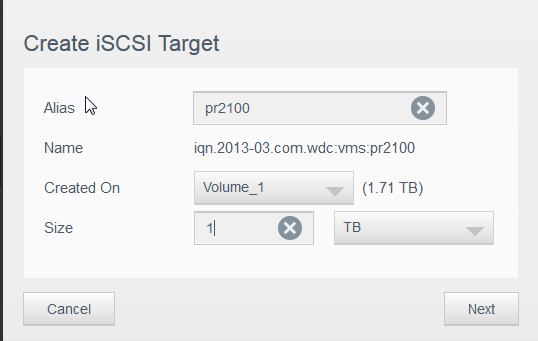This is information on recovering a missing iSCSI image on the WD MyCloud EX4100 NAS.
Manually reconfigure the iSCSI configuration file
- Power OFF and ON the unit
- Enable SSH and log into the device
For assistance enabling SSH, please see Answer ID 10435: How to enable SSH (Secure Shell) on a My Cloud
- Open a terminal emulator such as PuTTY on a Windows PC or use Terminal from Utilities on a Mac
- Use the cd command and go to the iSCSI image directory
cd /mnt/HD/HD_a2/.systemfile/iscsi_images
- Use the List command to get the name of the image
Your image name will be different
ls

EXAMPLE OUTPUT:
- Use the du -sh command to get the size of the image file
Your image size will be different
du -sh /mnt/HD/HD_a2/.systemfile/iscsi_images/pr2100.img
EXAMPLE OUTPUT: 932G /mnt/HD/HD_a2/.systemfile/iscsi_images/pr2100.img

- Go to Storage > iSCSI in the dashboard
- Create a new iSCSI target using the exact same name and of the iSCSI image file.
| Important: The new iSCSI target will assume the size of the disk image when created. The name must be identical, case sensitive, to the original iSCSI target.EXAMPLE: pr2100 and PR2100 are two different iSCSI image names.The size of the volume must be higher than the number 0, and should be a whole integer equal or larger than the actual image size found from the previous step.For a 1.9T image, create a 2 TB iSCSI image of the same nameFor a 2.9T image, create a 3 TB iSCSI image of the same nameFor a 3.9T image, create a 4 TB iSCSI image of the same nameetc… |

Data Recovery Options
- If the iSCSI target does not mount and the iSCSI image is present on the unit, transfer this image to an external storage location and use a third party utility to read the contents of the image.
WD does not provide support for 3rd party software.
| Note: | Using a 3rd party FTP/SSH client software, such as WinSCP (For Window), or FUGU SSH (For Mac) in order to facilitate locating and transferring the iSCSI image to an external location. Windows 8, 8.1, and 10 may be able to mount this iSCSI image automatically, or Disk Utility from Mac. 7-Zip has also been effective in reading iSCSI images. |
- If the iSCSI target continues to fail to mount, and the data is needed, please visit one of our data recovery partners
Important: Western Digital does not perform data recovery services. If data recovery is needed, please see Western Digital’s Data Recovery page.
Delete the iSCSI Image
If the iSCSI target does not mount, the data is not needed, the image can be deleted using the rm -rf command.
| Critical: The following process is Data Destructive. All data in the iSCSI image will be deleted. |
- Use the rm -rf command to force the deletion of the iSCSI image
rm -rf /mnt/HD/HD_a2/.systemfile/iscsi_images/pr2100.img
Use of Third-Party Software or Websites
We may recommend use of software, information, products, or websites that are owned or operated by other companies. We offer or facilitate this recommendation by hyperlinks or other methods to aid your access to the third-party resource. While we endeavor to direct you to helpful, trustworthy resources, We cannot endorse, approve, or guarantee software, information, products, or services provided by or at a third-party resource or track changes in the resource. Thus, we are not responsible for the content or accuracy of any third-party resource or for any loss or damage of any sort resulting from the use of, or for any failure of, products or services provided at or from a third party resource. WD recommends these resources on an “as is” basis. When you use a third party resource, you will be subject to its terms and licenses and no longer be protected by our privacy policy or security practices, which may differ from the third policy or practices or other terms. You should familiarize yourself with any license or use terms of, and the privacy policy and security practices of, the third party resource, which will govern your use of that resource.


